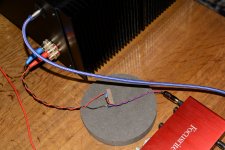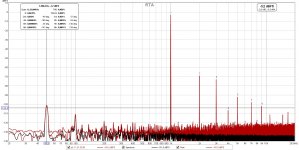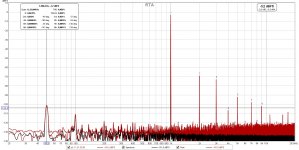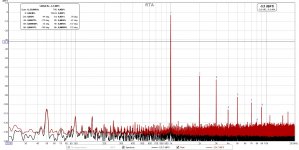If the fuse value is adequately small to protect a single transformer of the two, then
you should be fine. Generally audio power transformers are run at a fraction of their
rating.
Gotcha, thank you!!
I do this in my pre-amp. It has three transformers, but the fuse is just slightly over the rating for the smallest of them.If the fuse value is adequately small to protect a single transformer of the two, then
you should be fine. Generally audio power transformers are run at a fraction of their
rating.
My comment was specific to using a 4A fuse with a pair of 235VA transformers, or some other situation where the fuse rating is twice (or more) the current rating of the transformer. In the unlikely event that a mouse chewed through the wires to transformer A, died of electrocution, and its corpse shorted out transformer B just enough to cause it to overheat and set them amp on fire, the smaller fuse will blow while the larger fuse will cause a real mess.
Seriously though, it is not hard to think up a realistic scenario where a 4A fuse on a pair of 235VA transformers could be a real issue.
-Josh
P.S. just wanted to say a personal thanks to Mr. Pass for making the M2 available.
I recently visited PS audio, and listened to their BHK system with the legendary IRS 5 speakers. As amazing as that system sounds (it will make a grown man cry), it did not make my system sound bad, if anything, I felt mine did a few things better. The M2 and B1 are truly worthy.
I made my first distortion measurements on M2X mono block using REW software. I made a "quick and dirty" adapter from banana speaker out to RCA connector and a voltage divider (10:1). Measurements is with 5.3V RMS out in a 6.8 ohm resistor so 4.1 W which is relative high output. The measurement shows 2nd harmonic dominans which is different from FW M2 which is 3rd harmonic. Input board is standard Tucson. I think distortion is on par with FW M2? …..I am a little disappointed with the relative large 50 Hz noise but I can see that some is from external pickup of the adapter I made. If I try to screen with mu-metal etc. I can get it some dB down also if I put my hand on the chassis it drops a few dB. I have no earth connection in the outlet so this could also reduce it if I get earth wire installed. The 100 Hz noise is relative low so it seems PSU filtration is ok and Edcor pickup is minimal?
Will see if other mono block shows same result. It is my intention to make a small adapter box in metal with chassis mount female banana and RCA connectors to reduce noise pickup so what I measure is from amp and not from environment. Warm up was about 1/2 hour.
Will see if other mono block shows same result. It is my intention to make a small adapter box in metal with chassis mount female banana and RCA connectors to reduce noise pickup so what I measure is from amp and not from environment. Warm up was about 1/2 hour.
Attachments
I’ve had quite a bit of time with the M2x now.
I’m not qualified to post a “review”. However, FWIW, I am extremely happy with the results. It could be new toy syndrome, but who cares? Of the amps I currently have, I find myself listening to it most often.
I had a few others come for extended listening sessions. Everyone seems to enjoy it quite a bit. I did a few very casual A/Bs with some listeners blind. It's a great amp.
If you want to avoid bias on daughter cards… skip the following. I try not to read others’ opinions before I form my own. Unless changes are pronounced, I find that my opinions differ from others’ anyway. It could be my lousy ears, the rest of the components in my chain, my (lack of) taste in music, or my room. Pick an excuse.
For those that are interested…
DAUGHTER CARDS - MORE THOUGHTS
It’s may seem odd to those that have listened to all the daughter cards, but for now the Norwood is my “daily driver”. I’ll be basing most comparisons in the future off of the Norwood.
I found the Austin and Norwood cards to be the most interesting. I’ve put at least 10 hours or so on each card. The Norwood, Austin, and Tucson (with the TI OpAmp) getting the most attention with much more than 10 hours each. The Norwood probably has over 50 hours on it by now.
I fully expected the Ishikawa (set to “neutral” on the pots and with the Toshiba FETs) and the Mountain View to be my favorites. Expectation bias be darned… They found their way to the bottom on my level of interest. The Ishikawa may be the most neutral. I don’t know, but it lacked some character and detail that I feel I get from the others. The Mountain View truly surprised me. It has (to my ears) an “edge”, which I cannot quite place. It may be my least favorite. I expected the Class A operation to give it the most laid back in presentation. Shows what I know…
Tucson may be my favorite, and I am looking forward to rolling some OpAmps. I got some extra boards from Mark and have socketed the OpAmps on the boards in the initial build.
So why am I so fascinated by Austin and Norwood? Austin is the only one that altered the overall frequencies or my perception of them. It seems to add a bit to the top end without making it harsh. Cymbals sound fantastic and the soundstage seems to open up in all three dimensions. The soundstage aspect is the most fascinating to me. It just seems right. Norwood seems to do everything just that little bit better than all the other cards (except the unique aspects of Austin) without bringing out any particular characteristic. I find myself just wanting to go back to the Norwood. It seems easy to compare against as a very good middle-ground baseline.
It may be that I built a few of them wrong etc. etc. Opinions are fun, but I certainly wouldn't base what to build off mine.
I still recommend building them all, but ... it'd be hard for me personally to recommend spending the money on the Toshiba FETs unless you're just that curious and have the money in the budget.
So... to Mark and Jim - if your one of your goals was to bring an incredible amp to the DIY group and offer some options using modern / cheaper parts than the unobtainium Toshiba FETs. Well-Done and Thank You!
WHAT'S NEXT
Not that I’m hooked on DIY or anything… I can quit any time I want… I really can…
• Make some updates for a common base PSU and chassis for all the future First Watt amps. Possibly duplicate or make changes to have a base for monoblocks.
• Measurements I’d like to try.
• Figure out a simple way to bypass the IPS altogether. My pre-amp has a 1Ohm output impedance and plenty of gain.
• Build the SissySIT once the boards arrive and order some Aleph J once boards they are back in stock.
• Research the F4; I think my speakers like some current. I have both a pre-amp with a lot of gain and up to 20V output along with a tube amp. That could be fun to play with in combinations.
Fun stuff!
I’m not qualified to post a “review”. However, FWIW, I am extremely happy with the results. It could be new toy syndrome, but who cares? Of the amps I currently have, I find myself listening to it most often.
I had a few others come for extended listening sessions. Everyone seems to enjoy it quite a bit. I did a few very casual A/Bs with some listeners blind. It's a great amp.
If you want to avoid bias on daughter cards… skip the following. I try not to read others’ opinions before I form my own. Unless changes are pronounced, I find that my opinions differ from others’ anyway. It could be my lousy ears, the rest of the components in my chain, my (lack of) taste in music, or my room. Pick an excuse.
For those that are interested…
DAUGHTER CARDS - MORE THOUGHTS
It’s may seem odd to those that have listened to all the daughter cards, but for now the Norwood is my “daily driver”. I’ll be basing most comparisons in the future off of the Norwood.
I found the Austin and Norwood cards to be the most interesting. I’ve put at least 10 hours or so on each card. The Norwood, Austin, and Tucson (with the TI OpAmp) getting the most attention with much more than 10 hours each. The Norwood probably has over 50 hours on it by now.
I fully expected the Ishikawa (set to “neutral” on the pots and with the Toshiba FETs) and the Mountain View to be my favorites. Expectation bias be darned… They found their way to the bottom on my level of interest. The Ishikawa may be the most neutral. I don’t know, but it lacked some character and detail that I feel I get from the others. The Mountain View truly surprised me. It has (to my ears) an “edge”, which I cannot quite place. It may be my least favorite. I expected the Class A operation to give it the most laid back in presentation. Shows what I know…
Tucson may be my favorite, and I am looking forward to rolling some OpAmps. I got some extra boards from Mark and have socketed the OpAmps on the boards in the initial build.
So why am I so fascinated by Austin and Norwood? Austin is the only one that altered the overall frequencies or my perception of them. It seems to add a bit to the top end without making it harsh. Cymbals sound fantastic and the soundstage seems to open up in all three dimensions. The soundstage aspect is the most fascinating to me. It just seems right. Norwood seems to do everything just that little bit better than all the other cards (except the unique aspects of Austin) without bringing out any particular characteristic. I find myself just wanting to go back to the Norwood. It seems easy to compare against as a very good middle-ground baseline.
It may be that I built a few of them wrong etc. etc. Opinions are fun, but I certainly wouldn't base what to build off mine.
I still recommend building them all, but ... it'd be hard for me personally to recommend spending the money on the Toshiba FETs unless you're just that curious and have the money in the budget.
So... to Mark and Jim - if your one of your goals was to bring an incredible amp to the DIY group and offer some options using modern / cheaper parts than the unobtainium Toshiba FETs. Well-Done and Thank You!
WHAT'S NEXT
Not that I’m hooked on DIY or anything… I can quit any time I want… I really can…
• Make some updates for a common base PSU and chassis for all the future First Watt amps. Possibly duplicate or make changes to have a base for monoblocks.
o Continue to learn what “motor run” caps do and maybe try to implement them.
o Maybe add a set of XLR inputs
o Add a case to the toroid and potentially remount it.
• Measurements I’d like to try.
o Overall noise on the M2x. I think I’m not doing something correctly. I get 0V AC with the inputs shorted. My DMM measures to the microvolt, and I understand that 50mV is common with 20mV being good.
o Measure the distortion characteristics and tune the Tucson. This should be very fun. At the moment, even REW is over my head.
• Swap the caps on the M2x boards to the recommended Nichicons or pick some others and possibly try “bypassing”. That seems to be an interesting discussion. I used some standard Panasonic NPs when the Nichicons were out of stock. I didn’t realize that the “green ones” were highly recommended. It’ll be fun to see what all the fuss is about re: caps.• Figure out a simple way to bypass the IPS altogether. My pre-amp has a 1Ohm output impedance and plenty of gain.
• Build the SissySIT once the boards arrive and order some Aleph J once boards they are back in stock.
• Research the F4; I think my speakers like some current. I have both a pre-amp with a lot of gain and up to 20V output along with a tube amp. That could be fun to play with in combinations.
Fun stuff!
Last edited:
ItsAllInMyHead, it sounds like you're having plenty of fun, which is after all the end goal of having a hobby. Congratulations!
If your preamp can deliver a 3.5 volt sinewave into a 500 ohm load then your intuition is right: you can run your M2x without any daughter card at all. That's how Nelson Pass designed the original M2, and then at the very end he added his version of Ishikawa so that customers with vacuum tube preamps or "passive preamps" could use and enjoy an M2 as well.
Here is one simple way to do the bypass: #752 in another thread.
One set of experiments which you didn't mention, involves Major Surgery and requires General Anesthesia. You'll have to unplug all the 1/4" Faston connectors and remove the two amplifier boards from the heatsinks. Experiment: Increase the DC bias current in the M2x output stage and listen for improvements / no change at all / degradations to the sound. Do this with both 4 ohm speakers and 8 ohm speakers. You'll have to decide how much extra bias current you want, and then do a few calculations to find out the new component values which result in that new, bigger, current. And this is FUN!
Another member bought himself a couple more Edcor PC600-15K transformers to experiment with, and then he measured their frequency response while varying the output Zobel network (R5 and C1 on the official M2 schematic). You might find that you like the measured numbers better with different R5 and C1 than Nelson Pass selected. And you also might find that you like the sound of the amplifier better, with your Zobel instead of NP's Zobel. If you decide to try this, I suggest you download the white papers by Bill Whitlock on the Jensen Transformers website. They tell how Bill optimizes a transformer loading Zobel.
If your preamp can deliver a 3.5 volt sinewave into a 500 ohm load then your intuition is right: you can run your M2x without any daughter card at all. That's how Nelson Pass designed the original M2, and then at the very end he added his version of Ishikawa so that customers with vacuum tube preamps or "passive preamps" could use and enjoy an M2 as well.
Here is one simple way to do the bypass: #752 in another thread.
One set of experiments which you didn't mention, involves Major Surgery and requires General Anesthesia. You'll have to unplug all the 1/4" Faston connectors and remove the two amplifier boards from the heatsinks. Experiment: Increase the DC bias current in the M2x output stage and listen for improvements / no change at all / degradations to the sound. Do this with both 4 ohm speakers and 8 ohm speakers. You'll have to decide how much extra bias current you want, and then do a few calculations to find out the new component values which result in that new, bigger, current. And this is FUN!
Another member bought himself a couple more Edcor PC600-15K transformers to experiment with, and then he measured their frequency response while varying the output Zobel network (R5 and C1 on the official M2 schematic). You might find that you like the measured numbers better with different R5 and C1 than Nelson Pass selected. And you also might find that you like the sound of the amplifier better, with your Zobel instead of NP's Zobel. If you decide to try this, I suggest you download the white papers by Bill Whitlock on the Jensen Transformers website. They tell how Bill optimizes a transformer loading Zobel.
50 mV AC is not normal......it would be very bad. It is 50 mV DC (DC offset) which is normal and 20 mV DC good…..but with M2X you can get down to 1 mV DC. AC at output shall be much less then 1 mV.….so uV just fine.
Thank you for the correction and context. I'm obviously still learning. I got the DC offset to essentially stabilize a 0. It sways up and down with temp, but once the amp is at operating temperature, it's much less than 20mV. Rarely does it go beyond + or - 5 mV.
I just rechecked my notes. I should be more careful with units. The manual for the M2 states 500uV (AC). So, I still should not be getting a zero reading.
I'm clearly doing something incorrectly. My DMM is autoranging and should be able to pick up an AC voltage in that range or lower. It shouldn't be 0. I'll keep at it.
Thanks again!
Less AC at output with shorted input is better. 500 uV noise is rather high. 0 VAC at output is much better. 0 VAC is the optimal goal which means "no noise". You should not try to get 500 uV if you have 0 uV. Usally a very good amp has 100 uV or less noise (AC). Probably you have some uV noise…...even your DMM reads 0. I have 100 uV (0.1 mV) resolution on my DMM and my DMM reads 0.0 mV at output which means less than 50 uV noise…..but DMM are not very accurate at these small noise levels…..so it could also be 70uV.....but probably less than 100 uV.
@Mark Johnson -
Thanks as always. Cut and pasted into my notes for future consideration. Until I get another First Watt amp built - I just can't bring myself to perform any major surgeries. I'm easing myself into things...
What's encouraging is that a few short months ago everything in your post would have flown WAAAAAAAY above my head. Now, I understand most of what you wrote, with the exception that I haven't the foggiest clue what a "Zobel" might be or how it may affect things. More fun reading. That may be DIY 201... I'm still trying to test out of 101 with AP credit. The good news is that I do have a stash of unused Edcors. I'll use two for the SissySit, but if there are measurements to do beforehand for either amp, I'll see what I can learn and if I can apply that knowledge.
The good news is that I do have a stash of unused Edcors. I'll use two for the SissySit, but if there are measurements to do beforehand for either amp, I'll see what I can learn and if I can apply that knowledge.

Thanks as always. Cut and pasted into my notes for future consideration. Until I get another First Watt amp built - I just can't bring myself to perform any major surgeries. I'm easing myself into things...
What's encouraging is that a few short months ago everything in your post would have flown WAAAAAAAY above my head. Now, I understand most of what you wrote, with the exception that I haven't the foggiest clue what a "Zobel" might be or how it may affect things. More fun reading. That may be DIY 201... I'm still trying to test out of 101 with AP credit.

Less AC at output with shorted input is better. 500 uV noise is rather high. 0 VAC at output is much better. 0 VAC is the optimal goal which means "no noise". You should not try to get 500 uV if you have 0 uV. Usally a very good amp has 100 uV or less noise (AC). Probably you have some uV noise…...even your DMM reads 0. I have 100 uV (0.1 mV) resolution on my DMM and my DMM reads 0.0 mV at output which means less than 50 uV noise…..but DMM are not very accurate at these small noise levels…..so it could also be 70uV.....but probably less than 100 uV.
Understood with thanks. I know I shouldn't be trying to increase the noise, but given all the conversations around shielding the Edcors etc. etc. etc., I thought I'd have some noise that would register on my DMM as a registered AC voltage. It's great to know that others have achieved noise in the range below which a common DMM may register. That is extremely useful (and indicates that I may have done a few things right in the build).
I still go by my ears which indicate no audible noise with my ear pressed to the grills with 98dB/2.83V/1m speakers. So that's the good news.
I'm trying to learn some of the simpler measurement techniques and appreciate all the insight. Once I get the basics down, I may try some more sophisticated measurements.
A good way to measure noise is using the Arta or REW software and external sound card. This also shows where the noise is if it is 50/60 Hz, 100/120 Hz or something else. It is necessary to know if you want to do something about it. But with no audible noise with 98 dB speakers with ears close to the units indicates very low noise. I like to measure everything before I connect amp to speakers. I have MoFo's running with BA3-pre so not in absolute need for another amp  …..I am thinking of where to "store" MoFo's…...they are 30 kg each…..
…..I am thinking of where to "store" MoFo's…...they are 30 kg each…..
A good way to measure noise is using the Arta or REW software and external sound card. This also shows where the noise is if it is 50/60 Hz, 100/120 Hz or something else. It is necessary to know if you want to do something about it. But with no audible noise with 98 dB speakers with ears close to the units indicates very low noise. I like to measure everything before I connect amp to speakers. I have MoFo's running with BA3-pre so not in absolute need for another amp…..I am thinking of where to "store" MoFo's…...they are 30 kg each…..
Thank you for confirming. I've read the recent REW thread and a bit about ARTA. It's all still a bit foreign to me, and it seems that there is still a lot of conversation even among experts re: how to measure properly with both accuracy and consistency. So, until I get a better feeling for how to properly execute the measurements and interpret the results from both ARTA and REW, I'm waiting. I also hope to learn how to use REW as a potential tool for understanding some of the oddities in my room and how to compensate for or alleviate them.
A friend of mine has an analog scope and potentially a distortion analyzer he can let me use. His family is also pretty well-versed in some of the "art" and science behind audio (and other signal) measurements. In return for a few meals, some excellent camaraderie, and a beverage or two, I hope to have them teach me a thing or two in practicum.
After building the M2x, I took a pause and just listened for a while with friends. I never want to lose sight of the fact that although I am thoroughly enjoying learning about amps and how to build them... the end goal is the music.
Now... the itch hit again, and I wanted to see what else I could learn.
Now I also got a measurement on 2nd M2X mono block. Have attached both results for comparation. Think they are similar enough in performance to call it "stereo". Next step is to set it up for a listening test.....maybe in the weekend...….but hard to believe Korg + M2X can beat BA-3 + MoFo? ….let's "see" 
Attachments
Ok.....this is with 5.3 V RMS out in 6.8 ohm. The supply is an old school CRCLC with 4-pole Jensen as last caps. Since both channels looks identical in distortion and also match what you got then everything should be ok......even that M2 in theory should be 3rd harmonic dominant. 2nd harmonic probably from Edcor?
Now I also got a measurement on 2nd M2X mono block.
Since the M2x has different FFT footprints when different daughter cards are installed, it's Best Practice to mention exactly which daughter card was used for the measurement.
And in the specific case of the "Tucson" daughter card, where many different opamps can be used, it's Best Practice to mention exactly which opamp was used on your particular Tucson daughter card.
Another option for an M2X compatible input board is now available - it’s based on the PCA (Pocket Class A) JFET input and MOSFET source follower. It will provide about 12dB gain so no need for a separate preamp. Board also works on the Yarra preamp of course. JPS64 did a great job on the layout and this board has a built in CRCRC to help clean up the positive rail. Provides choice of 2SK209, BF862, and 2SK170 input JFET footprints. The latter two, becoming almost unobtainium. Each one has a different setup so follow values on table provided.
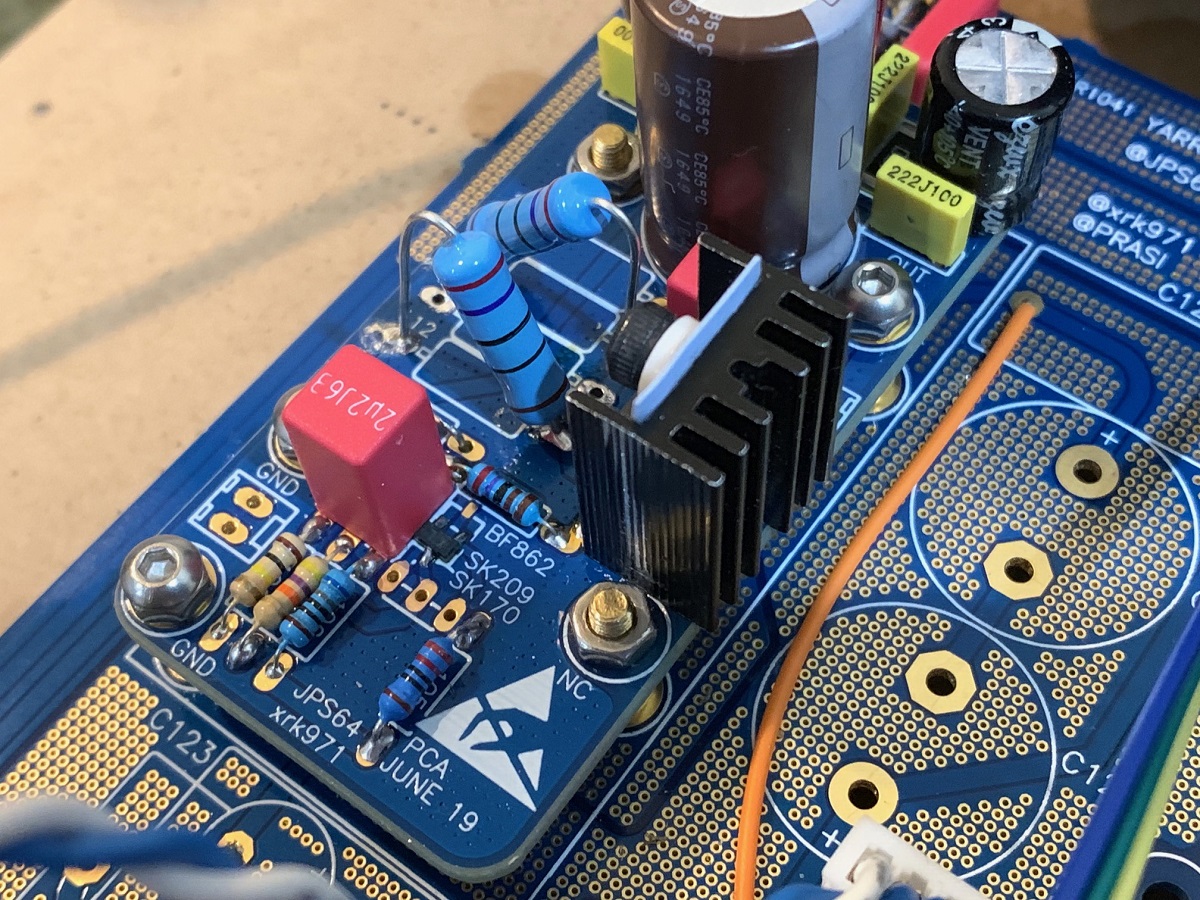
I have tried it on an M2X yet, but should work well. I have used it in the Aksa Lender chassis to drive the M2X (Austin) and that sounds great.
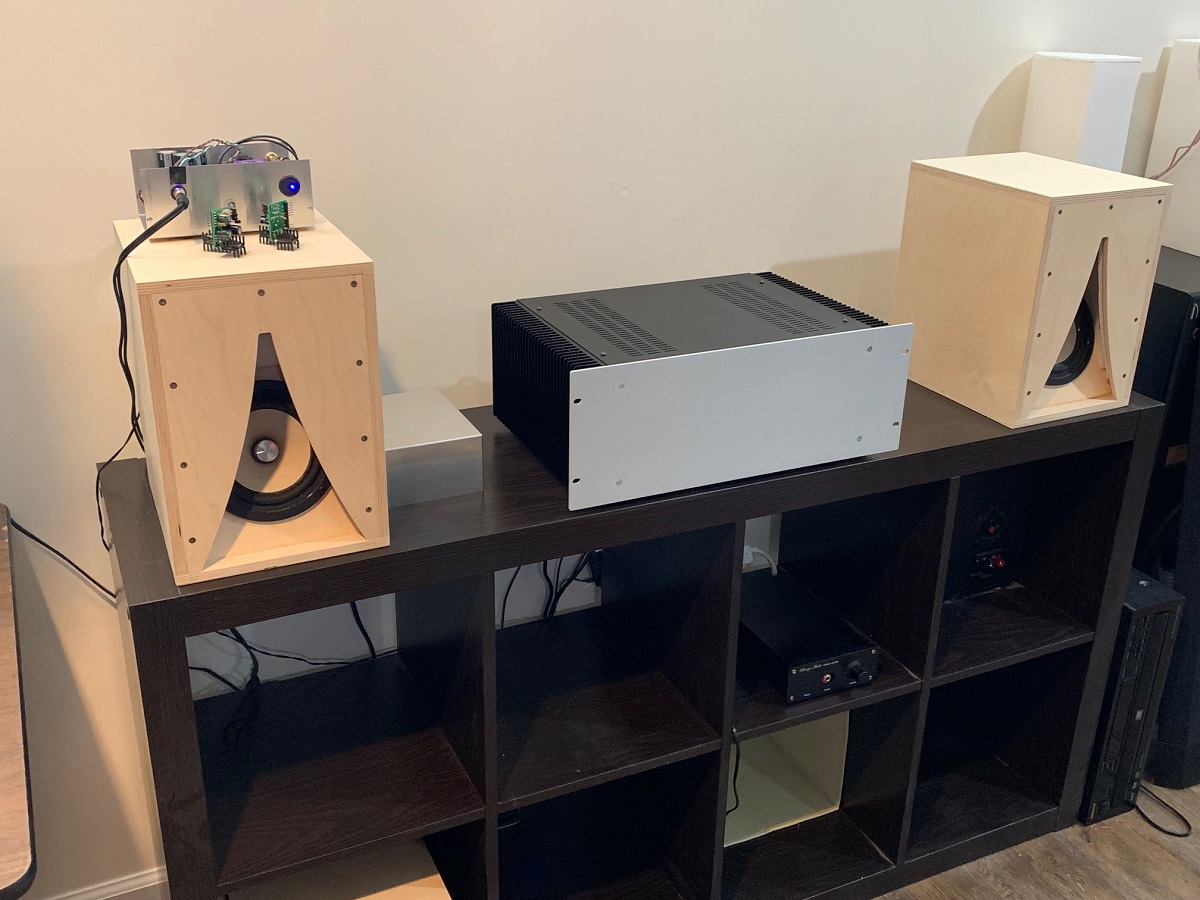
I have tried it on an M2X yet, but should work well. I have used it in the Aksa Lender chassis to drive the M2X (Austin) and that sounds great.
Last edited:
If the new board is an inverting amplifier like the PCA was, be sure to notify users to swap the (+) and (-) plugs of their loudspeaker cables. Just as Nelson Pass alerts builders of the Amp Camp Amp to swap (+) and (-). {Amp Camp Amp is another inverting amplifier.}
PCA consisted of a JFET input stage (inverting) with a MOSFET source follower (noninverting) output stage.
PCA consisted of a JFET input stage (inverting) with a MOSFET source follower (noninverting) output stage.
- Home
- Amplifiers
- Pass Labs
- The diyAudio First Watt M2x
